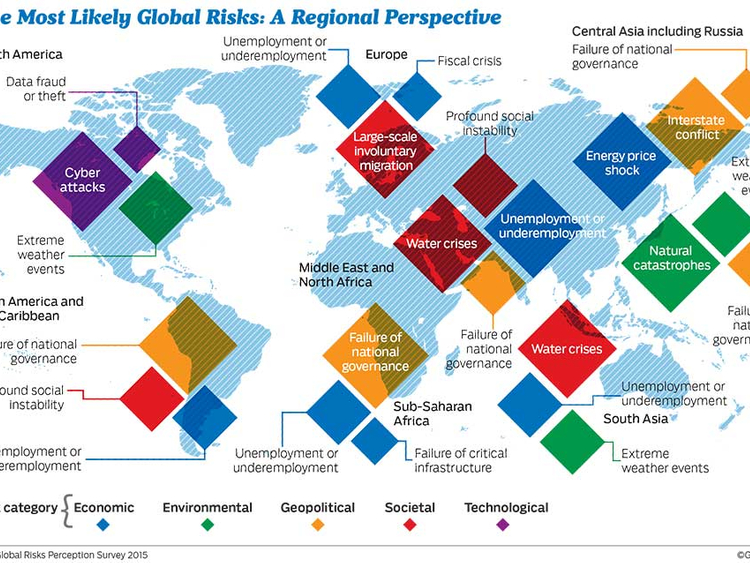|
|
|
“There are considerable economic headwinds for the Gulf region in 2017,” Richard Smith-Bingham, Director of the Global Risk Center at Marsh & McLennan Companies, said in an interview on Sunday.
The growth of Gulf countries over the past two has been hit by a plateau in trade, a persistent low oil price environment and fiscal weaknesses.
This is the historical backdrop to the set of questions that now face the region following the political resets of 2016, according to Smith-Bingham.
He is the author of the World Economic Forum’s Global Risks Report 2017, released in January at the nonprofit’s annual conference in Davos, Switzerland.
Traumatic year
“For most, 2016 was a traumatic year. The question is what does it mean for 2017 and beyond?”
It is hard to pinpoint the greatest risk to the region, said Smith-Bingham, adding it depends on which sector of the economy you’re in.
“If you’re a manufacturer exporting across the Gulf then it’s the overall strength of the regional economy that’ll be the critical thing,” he said.
If you’re trying to build out your business in the US, on the other hand, then there are a particular set of political and economic roadblocks ahead to that, he continued.
Key threats to the region
Key threats to the region Smith-Bingham cited included cybersecurity, protectionism, low oil prices and demographic issues.
The Gulf has been suffering under low oil prices since the crash in 2014, with an agreed output cut from Organisation of the Petroleum Exporting Countries (Opec) and non-Opec members helping to somewhat restore Brent crude, the global benchmark, to a more profitable level.
According to the risk report, executives in oil-exporting countries in the Middle East and North Africa are most concerned about the risk of an energy price shock, with low prices already leading to a decline of exports and revenue, and hurting public finances.
The director also spoke about a heightening of the “protectionist trade environment.”
“We’ve already seen an increase in discriminatory trade policies, and with the potential now for increased deregulation, tax cuts, and a home build agenda,” Smith-Bingham warned, “this will suck capital back to the US and raise the risk profile of emerging markets, reducing their attractiveness as places of investment.”
Perhaps unsurprisingly, most executives in the region also cited cybersecurity as a serious concern.
According to findings from US-based cybersecurity firm FireEye, 19 per cent of organisations in Saudi Arabia observed between January and June 2016 were exposed to at least one targeted attack. This figure was 14 per cent and 11 per cent for Qatar and the UAE respectively.
In the same time period, 28 per cent of government organisations across the Middle East were breached by a targeted attack at least once.
“The risk from cyber is huge. In fact it was the second biggest risk concerning UAE business leaders,” said Smith-Bingham.
He mentioned that the number of attacks had grown exponentially, spreading across multiple sectors.
“Government, energy, and telecommunications are all at risk, whilst state-sponsored cyberattacks have added a whole new dimension to the threat.”
The director warned that the adoption of new technology increased the chances of incidents taking place.
“With the increasing interconnectedness of devices to the internet, you’re broadening your attack surface,” he said.
Unexpected consequences
The Global Risks Report 2017 also placed heavy emphasis on the interconnections between these threats.
“The interplay between risks is key. They can amplify one another, and have cascading consequences in strange and interesting ways,” Smith-Bingham said.
“In this particular climate, there is a whole variety of individual headwinds which could turn in to a perfect storm, or they could combine in quite unpredictable ways, and it’s that sense of volatility and uncertainty that all companies need to be aware of and need to be looking for early warning signals of.”
Ultimately, he said, while there were a number of issues to consider, the real risk was from the surprises.
“We know what the issues are, we just don’t know how they’ll play out.”
Uncertainty breeds opportunity
According to Smith-Bingham, this unprecedented uncertainty also creates space for breakthroughs in business and policymaking.
“There are lots of risks out there, certainly more than we’ve seen for quite a while, but that doesn’t mean to say there aren’t opportunities.”
Despite global threats from which the Gulf is not immune, “these issues present a real chance for fresh thinking.”
“There is a need to adapt to the changing world, such as Vision 2030 in Saudi Arabia. There is a need to diversify, improve education systems, and improve health-care systems, for example.”
Smith-Bingham also cited the November 2016 announcement from the International Monetary Fund (IMF) that they would provide a $12 billion (Dh44 billion) loan to support the Egyptian government’s plans for economic reform, as an initiative with the potential to “build job rich opportunities for the middle classes.”
“Diversifying economies towards early investments in tech” is an important way for the Gulf to mitigate risks, according to Smith-Bingham, “whilst these global issues naturally accelerate a pivot eastward, in terms of regional expectations,” he said.














